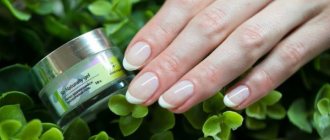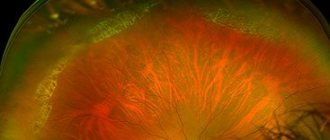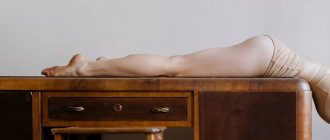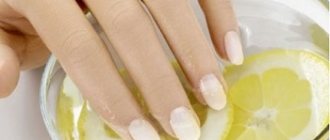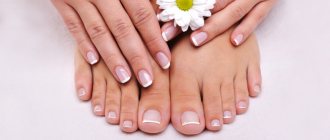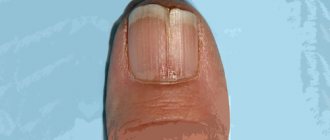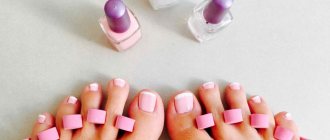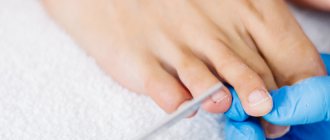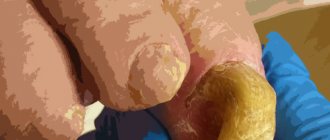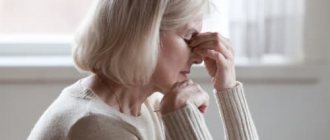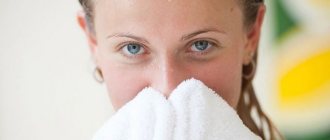Nail onycholysis is a dystrophic lesion of the nail plate, manifested in its separation from the bed while partially or completely maintaining its usual shape. Pathology develops with equal frequency on the fingers or toes. About 60% of detected cases of the disease are the consequences of injuries, up to 30% are formed under the influence of dermatomycosis. The remaining 10% are due to somatic diseases, dermatoses or pyoderma. The disease can develop in a person at any age; women are diagnosed more often than men. In case of traumatic damage to the nail, the pathology does not cause significant discomfort to the wearer; treatment is carried out for aesthetic reasons.
Reasons for development
Dermatologists distinguish three groups of causes for the development of the disease:
- injuries;
- mycoses;
- allergies.
The mechanism of development of onycholysis on the fingers is determined by the root cause of the pathology.
Traumatic injuries to the hands or feet affect the nails and nail bed. A subungual hematoma is formed between them, the vessels in the upper layers of the dermis are compressed, which leads to disruption of the nutrition of the nail, a change in its chemical composition and loss of elasticity. The plate is deformed, the connection between it and the bed weakens. Detachment occurs from the free edge. Violation of the fit increases the risk of infection and the development of inflammation. The nail root does not lose connection with the matrix. After the hematoma resolves, the plate grows as before.
Infectious onycholysis on the arms or legs occurs due to inflammation. The process includes three stages:
- alteration - pathological damage to the dermis, cells of the immune system produce cytokines and inflammatory mediators;
- exudation - disturbance of water-electrolyte balance in tissues, swelling of the nail, development of pathogenic microflora on the bed;
- proliferation - the development of hyperkeratosis of the nail bed with its subsequent deformation.
Normal growth of the nail plate begins after complete relief of the inflammatory process. Complicated onycholysis of fingernails or toenails will require the patient not only to comply with all medical prescriptions of the dermatologist, but also to follow a diet.
The allergic variant of the pathology develops according to a similar scenario to the inflammatory one. During the exudation stage, an excess amount of antibodies to pathogenic microflora is produced. This leads to increased sensitivity of the skin, increased deformation of the nail plate and the adjacent dermis. The regeneration process slows down significantly.
Kinds
Dermatologists distinguish several main types of pathology based on the clinical picture of the disease and the cause of damage to the patient’s nail plates. The most common types of onycholysis are:
- traumatic;
- dermatological;
- endocrine;
- systemic;
- fungal;
- bacterial;
- allergic.
Traumatic lesions of the nails occur after wounds or burns to the patient’s tissues. Probable causes remain splinters, excessive physical impact, and exposure to toxic or toxic substances. Toes can be hurt when wearing tight or poorly ventilated shoes.
The dermatological type of pathology develops under the influence of dermatoses, leading to disturbances in the processes of cellular nutrition in the affected area. Endocrine onycholysis results from humoral disorders in the human body or chronic disorders of the endocrine glands.
Systemic onycholysis is caused by diseases of the human digestive tract and subsequent metabolic disorders. The condition of the patient's tissues improves significantly after eliminating the disease that is the root cause of the separation of the nails from the bed.
The fungal type of pathology is formed after the formation of colonies of microfungi in the subungual space. The subsequent change in the nail bed almost does not affect the nail itself, which remains unchanged. The disease develops as a result of a long-term mycotic infection.
The bacterial course of onycholysis is the result of the addition of a secondary infection to any type of pathology. Allergic lesions of nail tissue develop when the patient takes medications, contacts with chemicals or directed ultraviolet radiation.
Prevention
To avoid the development of onycholysis, you must follow the rules for preventing the disease:
- Perform manicures and pedicures only by professional nail technicians, and avoid injuring your nails while caring for them.
- Use only high-quality coatings and liquids that clean the nail plates.
- When working with any chemicals and aggressive solutions, you must wear gloves.
- Eat right, be sure to include in your menu foods with plenty of iron, calcium, vitamins A , E , C , etc.
- Treat all chronic diseases in a timely manner, pay attention to unpleasant symptoms and consult a doctor in a timely manner.
- Wear only comfortable and high-quality shoes that do not pinch or cause discomfort.
- Monitor foot hygiene, change tights and socks every day. Don't try on other people's shoes.
- Use only personal hygiene items; in the bathhouse, sauna, swimming pool, wear rubber slippers.
- Use cosmetics to strengthen the nail plate.
- Strengthen the immune system : lead an active lifestyle, play sports.
As for whether it is possible to extend nails for people with onycholysis, it is recommended to do this only after recovery. But if there are pronounced cosmetic defects, extensions are used as a forced aesthetic measure. So, a doctor may suggest such extensions if a person is diagnosed with anonychia - the absence of one or more nails.
Symptoms on arms and legs
The clinical picture of the disease is the same for all types of pathology: the nail plate is separated from the bed from the free edge in the distal or lateral sections to the nail hole. The color of the plate changes from flesh-colored to gray-white due to air entering the subungual space. With the development of pathogenic microflora in the resulting free space, a further change in color is possible: yellow becomes the result of bacterial infections, brown - the formation of a colony of microfungi, green - damage to Pseudomonas aeruginosa.
Bacterial infections affect the structure and strength of the nail plate. The surface of the nails loses its shine, becomes rough and gradually becomes deformed. The subungual space is filled with dirt and keratin. This leads to the development of hyperkeratosis, characterized by an unpleasant odor. In advanced stages of the pathology, a focus of secondary inflammation may develop. Detachment of part of the nail is called partial onycholysis, while the entire plate is called total.
Diet
Antifungal Diet
- Efficacy: no data
- Terms: 3-6 months
- Cost of products: 1500-1600 rubles. in Week
Vitamin-protein diet
- Efficiency: 5 kg in 7-10 days
- Terms: up to 14 days
- Cost of products: 1700-1800 rubles. in Week
If you have problems with your nails, you should make some adjustments to your diet:
- Regularly consume protein foods, giving preference to dishes made from lean meat, dairy products, cheeses, and fish of all types.
- Be sure to eat dishes containing gelatin: jelly, jellies, etc.
- Eat fresh vegetables and fruits as often as possible. It is recommended to include broccoli and other types of cabbage, peppers, citrus fruits, and green leafy vegetables in the menu. It is also recommended to prepare drinks from rose hips, viburnum, and hawthorn.
- Legumes containing vegetable proteins are useful: lentils, beans, peas.
- The diet should include nuts containing antioxidants , vitamin E : peanuts, almonds, walnuts.
- B vitamins are important for recovery. They are found in offal, cottage cheese, milk, buckwheat, and brown rice.
- To provide the body with microelements important for nails, you should consume spinach, avocado, seaweed (sources of iodine); sesame, dairy products (calcium); liver, apples, pomegranate (iron); onions, cucumbers, greens (sulfur).
Seeing a doctor
Detecting the first symptoms of onycholysis is a good reason to visit the clinic. Any stage of the disease requires consultation with a dermatologist. During the diagnosis and treatment of the disease, the patient may require the opinions of other specialists: an endocrinologist, a surgeon, a therapist.
Ignoring the symptoms of pathology can lead to multiple damage to the nail plates on the patient’s hands and feet, the formation of numerous foci of infection and damage to other tissues and systems of the body.
Are you experiencing symptoms of onycholysis?
Only a doctor can accurately diagnose the disease. Don't delay your consultation - call
In children
The disease can develop in people of any age. It is also diagnosed in children. Onycholysis in a child can manifest itself against the background of systemic diseases, malnutrition, deficiency of vitamins and minerals, and nervous shock. Nail plates sometimes peel off in children who constantly bite their nails. In addition, the child may become infected with a fungal infection. Such manifestations in children cannot be ignored. It is necessary to visit a dermatologist who will determine the causes and prescribe treatment.
Diagnostics on legs and arms
The diagnosis is made during a visual examination of the patient by a dermatologist. The development of onycholysis is preceded by damage to the nail plates by Bo lines, which occur against the background of damage to the nail matrix. This sign indicates systematic injuries or the presence of somatic pathologies.
A mandatory stage of clinical tests is obtaining scrapings from damaged tissues to conduct laboratory tests and exclude mycotic lesions of the nail and nail bed. Differential diagnosis of onycholysis is carried out with mycoses, psoriasis, lichen planus, Bowen's disease and onychodystrophies of unknown etiology.
Different types of onycholysis on the fingers or toes will require in-depth analyzes to establish the causes of the development of pathology with multiple clinical pictures. The reason for this is the variety of colors of the nail plates, visible differences in their structure, transparency, and area of hyperkeratotic layering.
General information
Onycholysis is a condition when the nail peels off from the nail bed - the soft tissue of the finger.
In this case, a void is formed, and the nail plate gradually changes color if we are talking about an infectious process. This phenomenon is quite common and can occur on the fingers and toes. At the same time, signs of onycholysis are more often observed in women of different age categories, which is associated with more thorough and frequent nail care. As a rule, onycholysis develops on one finger; in more rare cases, it affects several fingers at once. The main causes of the disease are injuries or dermatological diseases. Effective treatment of this disease is only possible if the doctor is able to correctly determine the cause of the pathology. How to recognize the disease and how to choose the right treatment tactics will be discussed in this article.
Treatment of nail onycholysis
Pathology requires complex therapy. The key task is to treat the underlying disease against which onycholysis of the nails develops. The allergic type of damage to the nail plate requires consultation of the patient with a nutritionist or gastroenterologist to adjust the functioning of the digestive system through diet. Correcting the imbalance of minerals and vitamins will reduce the likelihood of further progression of onycholysis.
The traumatic type of pathology involves daily removal of the growing tissue of the exfoliated area, followed by disinfection of the subungual space and protection of the bed with an antibacterial patch.
Large area detachments are treated surgically. After removing the nail plate, antibacterial and antiseptic dressings are applied to the bed. The operation allows surgeons to remove hyperkeratotic deposits, dirt and the consequences of hematoma development. Nail restoration is carried out using gelatin solutions of various concentrations.
Bacterial and mycotic lesions of the nail are treated with alcohol solutions of aniline paints, antibacterial and antifungal drugs.
During pregnancy
In pregnant women, this pathology occurs quite often. This may be due to the following reasons:
- Active hormonal changes during pregnancy.
- Decreased immunity .
- Lack of vitamins and minerals.
- Swelling and weight gain, leading to increased stress on the legs.
During the treatment process, expectant mothers are usually prescribed local remedies and are also recommended to take vitamin and mineral complexes for pregnant women. After consulting a doctor, you can use folk remedies.
Make an appointment
You can make an appointment with the specialists of JSC "Medicine" (clinic of Academician Roitberg) on the website - the interactive form allows you to select a doctor by specialization or search for an employee of any department by name and surname. Each doctor’s schedule contains information about visiting days and hours available for patient visits.
Clinic administrators are ready to accept requests for an appointment or call a doctor at home by calling +7 (495) 775-73-60.
Convenient location on the territory of the central administrative district of Moscow (CAO) - 2nd Tverskoy-Yamskaya lane, building 10 - allows you to quickly reach the clinic from the Mayakovskaya, Novoslobodskaya, Tverskaya, Chekhovskaya and Belorusskaya metro stations .
Baths
- Sea salt 1 tbsp + olive oil 1 tbsp. + lemon juice 1 tbsp + glass of water
- Gelatin+water
- Coniferous waters + chamomile + gelatin (mix everything in equal proportions)
2-3 times a week for 15 minutes
In some cases, nail prosthetics can be done in the salon, but you should be aware of the contraindications to this procedure:
- childhood
- open wounds
- diabetes
- allergic reactions to the material
- professional sports
